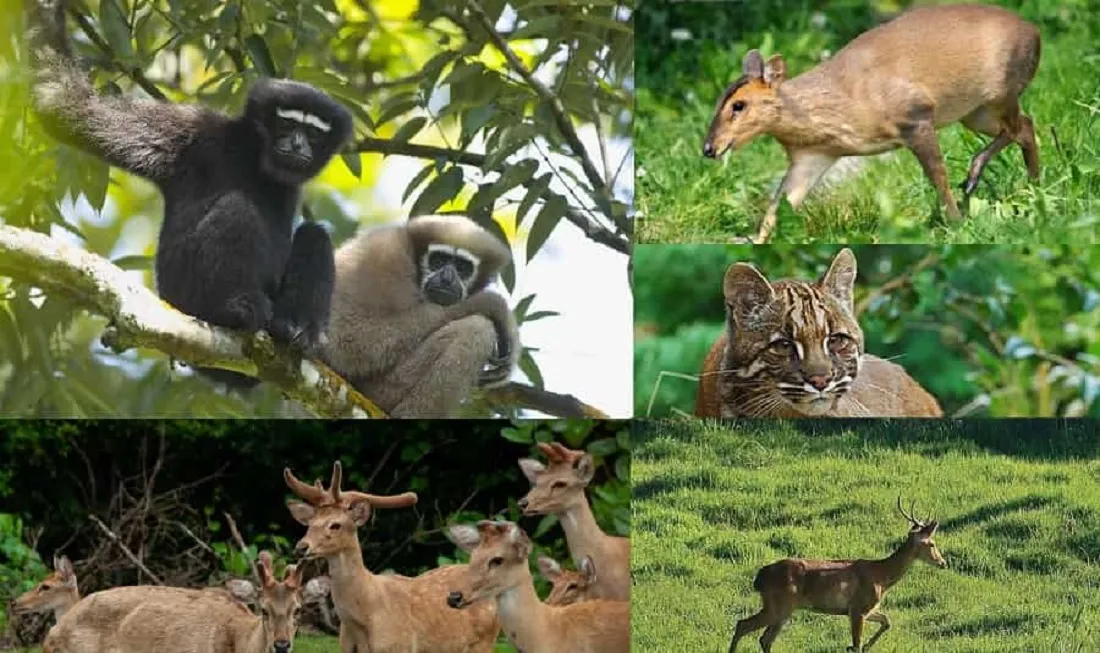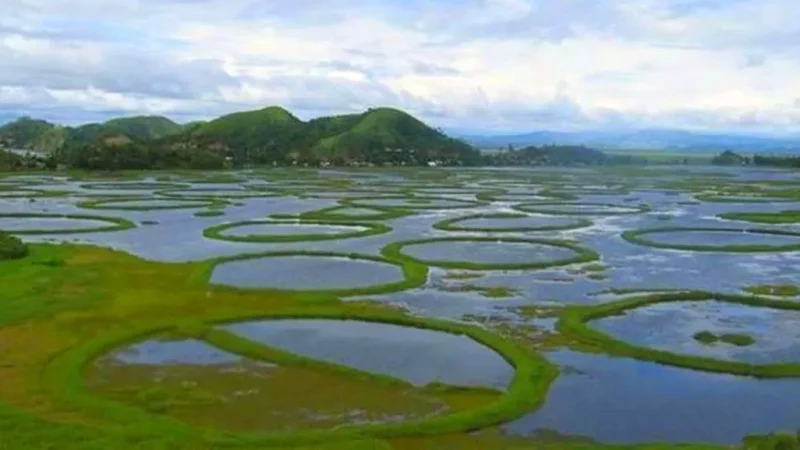7 Best Wildlife Sanctuary in Manipur

Manipur Wildlife Sanctuary :
Nestled in the northeastern embrace of India, Manipur is a land of picturesque landscapes, vibrant culture, and hidden natural treasures. While it may be known for its cultural diversity and the graceful movements of its classical dance form, Manipur also cradles a wealth of biodiversity within its borders. Join us on this virtual journey as we uncover the secrets of Manipur’s wildlife sanctuaries, where nature’s untamed beauty thrives amidst pristine forests and serene valleys.
In this blog, we embark on an adventure to unveil the lesser-explored wonders of Manipur’s wilderness. These sanctuaries, often tucked away in the folds of the state’s lush hills, are nature’s sanctums, where rare and elusive creatures find refuge and unique plant species thrive.
Wildlife Sanctuary of Manipur :
1- Keibul Lamjao National Park
Here is the information about Keibul Lamjao National Park in details:
- Location: Keibul Lamjao National Park is located in Bishnupur district, Manipur, India. It is situated on Loktak Lake, the largest freshwater lake in Northeast India.
- Area: It is spread over an area of 40 square kilometers (15.4 sq mi).
- Establishment: It was established in 1966 as a wildlife sanctuary and was upgraded to a national park in 1977.
- Main attractions: Sangai (brow-antlered deer), hog deer, wild boar, otter, python, great hornbill, lesser fish eagle, and the kingfisher.
- Best time to visit: November to March.
Things to do:
- Visit the Sangai Interpretation Centre to learn about the deer.
- Take a boat ride on Loktak Lake to see the floating phumdis.
- Go bird watching in the park.
- Hike or camp in the park.
2- Yangoupokpi-Lokchao Wildlife Sanctuary
Here is the information about the Yangoupokpi-Lokchao Wildlife Sanctuary:
- Location: The Yangoupokpi-Lokchao Wildlife Sanctuary is located in the Chandel district of Manipur, India. It is situated near Yangoupokpi, 110 kilometers (68 mi) from Imphal.
- Area: It is spread over 184.80 square kilometers (71.3 sq mi).
- Establishment: It was established in 1989.
- Main attractions: The sanctuary is famous for its hoolock gibbon population, the only ape species found in India.
- Other animals: Indian elephant, wild boar, leopard, slow loris, pangolin, capped langur, Malayan sun bear, Blyth’s kingfisher, great pied hornbill, rufous-necked hornbill, and many others.
- Best time to visit: October to April.
Things to do:
- Go on a jeep safari to see the wildlife.
- Go bird watching in the park.
- Take a walk or hike through the forest.
- Visit the Visitor Centre, which has a museum and an aquarium.
3- Siroi Hill Range
Here is the information about the Siroi Hill Range.
- Location: The Siroi Hill Range is located in the Ukhrul district of Manipur, India. It is situated near the town of Siroi, 120 kilometers (75 mi) from Imphal.
- Area: It is spread over 1,250 square kilometers (480 sq mi).
- Highest peak: Shirui Kashung Peak, at 2,835 meters (9,300 ft) above sea level.
- Main attractions: Shirui Lily, the state flower of Manipur.
- Other wildlife: Indian elephant, sambar deer, barking deer, Blyth’s kingfisher, great pied hornbill, rufous-necked hornbill.
- Best time to visit: March to May and September to November.
Things to do:
- Trekking: There are many trekking trails in the range, ranging from easy to challenging.
- Camping: There are many camping spots in the range, where you can enjoy the beauty of the mountains and the forest.
- Bird watching: The range is home to various birds, including the Blyth’s kingfisher, the great pied hornbill, and the rufous-necked hornbill.
- Wildlife photography: The range is a great place to spot wildlife, such as the Indian elephant, the sambar deer, and the barking deer.
The Siroi Hill Range is a beautiful and biodiverse mountain range. It is a great place to go trekking, camping, bird watching, and wildlife photography.
4- Khongjaingamba Ching Wildlife Sanctuary
Here is the information about the Khongjaingamba Ching Wildlife Sanctuary.
- Location: The Khongjaingamba Ching Wildlife Sanctuary is located in the Chandel district of Manipur, India. It is situated near Tengnoupal, 45 kilometers (28 mi) from Imphal.
- Area: It is spread over 34 square kilometers (13 sq mi).
- Establishment: It was established in 1983.
- Main attractions: Endangered hoolock gibbon, Indian elephant, sambar deer, wild boar, leopard.
- Best time to visit: October to April.
Things to do:
- Go on a jeep safari to see the wildlife.
- Go bird watching in the park.
- Take a walk or hike through the forest.
- Visit the Visitor Centre, which has a museum and an aquarium.
5- Yangoupokpi-Lokchao Wildlife Sanctuary
Here is the information about the Yangoupokpi-Lokchao Wildlife Sanctuary:
Location: The Yangoupokpi-Lokchao Wildlife Sanctuary is located in the Chandel district of Manipur, India. It is situated near the town of Yangoupokpi, 110 kilometers (68 mi) from Imphal.
Area: It is spread over an area of 184.80 square kilometers (71.3 sq mi).
Establishment: It was established in 1989.
Main attractions:
- The only population of hoolock gibbons in India.
- Indian elephant, wild boar, leopard, slow loris, pangolin, capped langur, Malayan sun bear, Blyth’s kingfisher, great pied hornbill, rufous-necked hornbill, and many others.
Best time to visit: October to April.
Things to do:
- Trekking
- Camping
- Bird watching
5- Yangoupokpi-Lokchao Wildlife Sanctuary
Here is the information about the Yangoupokpi-Lokchao Wildlife Sanctuary:
Location: The Yangoupokpi-Lokchao Wildlife Sanctuary is located in the Chandel district of Manipur, India. It is situated near the town of Yangoupokpi, 110 kilometers (68 mi) from Imphal.
Area: It is spread over an area of 184.80 square kilometers (71.3 sq mi).
Establishment: It was established in 1989.
Main attractions:
- The only population of hoolock gibbons in India.
- Indian elephant, wild boar, leopard, slow loris, pangolin, capped langur, Malayan sun bear, Blyth’s kingfisher, great pied hornbill, rufous-necked hornbill, and many others.
Best time to visit: October to April.
Things to do:
- Trekking
- Camping
- Bird watching
6- Zeilad Wildlife Sanctuary
Here is some information about the Zeilad Wildlife Sanctuary:
- Location: Zeilad Wildlife Sanctuary is located in the Tamenglong district of Manipur, India. It is situated near Tamenglong, 110 kilometers (68 mi) from Imphal.
- Area: It is spread over 21 square kilometers (8.1 sq mi).
- Establishment: It was proposed in 1997 but has yet to be declared a wildlife sanctuary.
- Main attractions:
- Tiger, leopard, leopard cat, small Indian civet, Common Langur, Hoolock gibbon, Great Indian Hornbill, barking deer, flying squirrel, Slow loris, Golden cat, yellow throated marten, large Indian civet cat, Hog badger, Bear, Serow, Sambar etc.
- Best time to visit: October to April.
Things to do:
- Go on a jeep safari to see the wildlife.
- Go bird watching in the park.
- Take a walk or hike through the forest.
7- Buning Wildlife Sanctuary
Here is some information about the Buning Wildlife Sanctuary:
- Location: Buning Wildlife Sanctuary is located in the Tamei subdivision in Tamenglong district, and is part of the Barail Range. The Barak river flows near the Sanctuary. Many streams originate from the catchment areas within the Sanctuary and feed the Barak.
- Area: It is spread over 115.8 square kilometers (44.7 sq mi).
- Establishment: It was established in 1998.
- Main attractions:
- Pygmy hog, the world’s smallest wild pig.
- Tiger, leopard, elephant, gaur, sambar, barking deer, capped langur, slow loris, and many others.
- Best time to visit: October to April.
Things to do:
- Go on a jeep safari to see the wildlife.
- Go bird watching in the park.
- Take a walk or hike through the forest.
Final Note:
In the heart of Manipur, where the hills echo with the calls of rare birds, and the forests conceal elusive creatures, these wildlife sanctuaries are guardians of nature’s treasures. From the world’s only floating national park, Keibul Lamjao, home to the iconic Sangai deer, to the serene landscapes of Siroi Hill Range and Yangoupokpi-Lokchao, each sanctuary offers a unique glimpse into the tapestry of life in this northeastern wonderland.
Yet, beyond the breathtaking landscapes and charismatic wildlife, we’ve discovered the heartbeats of conservation. In the dedication of local communities, the passion of conservationists, and the harmonious coexistence of humans and nature, we’ve witnessed a collective commitment to safeguarding these ecological treasures.
Our journey has reaffirmed the truth that these sanctuaries are not just refuges for wildlife but sanctuaries for our souls. They are places where we reconnect with the rhythms of the natural world and find solace, wonder, and inspiration.

